Inter-turn Short Circuit Diagnosis Using New D-Q Synchronous Min–Max Coordinate System and Linear Discriminant Analysis
Abstract
:1. Introduction
2. Turn Short and D-Q Transformation
2.1. Stator Failure
2.2. D-Q Transformaion
2.3. D-Q Transformation Analysis According to Turn Short
3. LDA
4. FAR–FRR Interaction Graph
5. Experiment and Discussion
5.1. Experimental Conditions
- Operation of an induction motor by using inverter;
- Adjustment of the motor operation speed by using dynamometer;
- The initial speed—the rated speed 1690 (rpm);
- Operating time—turn short per 30 (s);
- Sampling rate and the number of samplings: 10,000 (S/s), 10,000 (s).
5.2. D-Q Synchronous Min–Max Coordinate System
5.3. Efficient LDA Application Method
5.4. Light Load LDA Application Methods
6. Conclusions
Author Contributions
Funding
Conflicts of Interest
References
- Waide, P.; Brunner, C. Energy-Efficiency Policy Opportunities for Electric Motor-Driven Systems; IEA Energy Papers; OECD Publishing: Paris, France, 2011; pp. 1–132. [Google Scholar] [CrossRef]
- O’Donnell, P. Report of large motor reliability survey of industrial and commercial installations: Part I and II. IEEE Trans. Appl. 1985, IA-21, 853–872. [Google Scholar] [CrossRef]
- Radja, N.; Rachek, M.; Larbi, S.N. Non-Destructive Testing for Winding Insulation Diagnosis Using Inter-Turn Transient Voltage Signature Analysis. Machines 2018, 6, 21. [Google Scholar] [CrossRef] [Green Version]
- Wang, L.; Li, Y.; Li, J. Diagnosis of Inter-Turn Short Circuit of Synchronous Generator Rotor Winding Based on Volterra Kernel Identification. Energies 2018, 11, 2524. [Google Scholar] [CrossRef] [Green Version]
- Dybkowski, M.; Bednarz, S. Modified Rotor Flux Estimators for Stator-Fault-Tolerant Vector Controlled Induction Motor Drives. Energies 2019, 12, 3232. [Google Scholar] [CrossRef] [Green Version]
- Chen, Y.; Zhao, X.; Yang, Y.; Shi, Y. Online Diagnosis of Inter-turn Short Circuit for Dual-Redundancy Permanent Magnet Synchronous Motor Based on Reactive Power Difference. Energies 2019, 12, 510. [Google Scholar] [CrossRef] [Green Version]
- Goh, Y.J.; Kim, O. Linear Method for Diagnosis of Inter-Turn Short Circuits in 3-Phase Induction Motors. Appl. Sci. 2019, 9, 4822. [Google Scholar] [CrossRef] [Green Version]
- Glowacz, A. Recognition of acoustic signals of induction motor using FFT, SMOFS-10 and LSVM. Eksploat. I Niezawodn. 2015, 17, 569–574. [Google Scholar] [CrossRef]
- Duan, Z.; Wu, T.; Guo, S.; Shao, T.; Malekian, R.; Li, Z. Development and trend of condition monitoring and fault diagnosis of multi-sensors information fusion for rolling bearings: A review. Int. J. Adv. Manuf. Technol. 2018, 96, 803. [Google Scholar] [CrossRef] [Green Version]
- Stief, A.; Ottewill, J.R.; Baranowski, J.; Orkisz, M. A PCA and Two-Stage Bayesian Sensor Fusion Approach for Diagnosing Electrical and Mechanical Faults in Induction Motors. IEEE Trans. Ind. Electron. 2019, 66, 9510–9520. [Google Scholar] [CrossRef] [Green Version]
- Glowacz, A.; Głowacz, Z. Recognition of rotor damages in a DC motor using acoustic signals. Bull. Pol. Acad. Sci. Tech. Sci. 2017, 65, 187–194. [Google Scholar] [CrossRef] [Green Version]
- Glowacz, A.; Glowacz, W. Vibration-Based Fault Diagnosis of Commutator Motor. Shock Vib. 2018, 2018, 10. [Google Scholar] [CrossRef]
- Thomson, W.T.; McRae, C.J. On-Line Current Monitoring to Detect Inter-Turn Stator Winding Faults in Induction Motors. In Proceedings of the 24th Universities Power Engineering Conference, Belfast, UK, 19–20 September 1989. [Google Scholar]
- Cardoso, A.J.M.; Cruz, S.M.A.; Fonseca, D.S.B. Inter-Turn Stator Winding Fault Diagnosis in Three-Phase Induction motors, by Park’s Vector Approach. IEEE Trans. Energy Convers. 1999, 14, 595–598. [Google Scholar] [CrossRef]
- Cruz, S.M.A.; Cardoso, A.J.M. Stator winding fault diagnosis in three-phase synchronous and asynchronous motors, by the extended Park’s vector approach. IEEE Trans. Ind. Appl. 2001, 37, 1227–1233. [Google Scholar] [CrossRef]
- Jung, J.H.; Lee, J.J.; Kwon, B.H. Online Diagnosis of Induction Motors Using MCSA. IEEE Trans. Ind. Electron. 2006, 53, 1842–1852. [Google Scholar] [CrossRef]
- Cruz, S.M.A.; Cardoso, A.J.M. Rotor cage fault diagnosis in three-phase induction motors by Extended Park’s Vector Approach. Electr. Mach. Power Syst. 2000, 28, 289–299. [Google Scholar] [CrossRef]
- Parra, A.P.; Enciso, M.C.A.; Ochoa, J.O.; Peñaranda, J.A.P. Stator fault diagnosis on squirrel cage induction motors by ESA and EPVA. In Proceedings of the 2013 Workshop on Power Electronics and Power Quality Applications (PEPQA), Bogota, CO, USA, 6–7 July 2013; pp. 1–6. [Google Scholar] [CrossRef]
- Skowron, M.; Wolkiewicz, M.; Kowalska, T.O.; Kowalski, C.T. Application of Self-Organizing Neural Networks to Electrical Fault Classification in Induction Motors. Appl. Sci. 2019, 9, 616. [Google Scholar] [CrossRef] [Green Version]
- Go, Y.J.; Lee, B.; Song, M.H.; Kim, K.M. A Stator Fault Diagnosis of an Induction Motor based on the Phase Angle of Park’s Vector Approach. J. Inst. Control Robot. Syst. 2014, 20, 408–413. [Google Scholar] [CrossRef] [Green Version]
- Yang, C.O.; Park, G.N.; Song, M.H. Study on distortion ratio calculation of park’s vector pattern for diagnosis of stator winding fault of induction motor. Trans. Korean Inst. Electr. Eng. 2012, 61, 643–649. [Google Scholar] [CrossRef]
- Go, Y.J.; Song, M.H.; Kim, J.Y.; Choi, W.R.; Lee, B.; Kim, K.M. A New Algorithm for Analyzing Method of Electrical Faults of Three-Phase Induction Motors Using Duty Ratios Half-Period Frequencies According to Phase Angle Changes. Mechatronics and Robotics Engineering for Advanced and Intelligent Manufacturing. In Lecture Notes in Mechanical Engineering; Zhang, D., Wei, B., Eds.; Springer International Publishing: Cham, Switzerland, 2017; Volume 36, pp. 303–317. [Google Scholar]
- IEC 60034-1. Rotating Electrical Machines—Part 1: Rating and Performance; IEC: Geneva, Switzerland, 2010. [Google Scholar]
- ANSI/IEEE Std. IEEE Recommended Practice for Electric Power Distribution for Industrial Plants; ANSI/IEEE Std.: New York, NY, USA, 1993. [Google Scholar]
- IEEE Std. 519. IEEE Recommended Practices and Requirements for Harmonic Control in Electrical Power Systems; IEEE Std.: New York, NY, USA, 1992. [Google Scholar]
- Chang, H.C.; Jheng, Y.M.; Kuo, C.C.; Hsueh, Y.M. Induction Motors Condition Monitoring System with Fault Diagnosis Using a Hybrid Approach. Engergies 2019, 12, 1471. [Google Scholar] [CrossRef] [Green Version]
- Juan, G.B.; Juan, R.C.; José, R.M.; Pilar, G.G.; Hayde, P.B.; Vicente, A.A. An Approach on MCSA-Based Fault Detection Using Independent Component Analysis and Neural Networks. IEEE Tran. Inst. Measurement 2019, 68, 1353–1361. [Google Scholar] [CrossRef]
- Jeon, B.S.; Lee, D.J.; Lee, S.H.; Ryu, J.W.; Chun, M.G. Fault Diagnosis of Induction Motor by Fusion Algorithm based on PCA and LDA. J. Korean Inst. Iiium. Electr. Install. Eng. 2005, 19, 152–159. [Google Scholar] [CrossRef]
- Mbo’o, C.P.; Hameyer, K. Fault Diagnosis of Bearing Damage by Means of the Linear Discriminant Analysis of Stator Current Features from the Frequency Selection. IEEE Trans. Ind. Appl. 2016, 52, 3861–3868. [Google Scholar] [CrossRef]
- Frosini, L.; Zanazzo, S.; Beccarisi, F. Linear Discriminant Analysis for an Automatic Detection of Stator Faults in Induction Motor Drives. In Proceedings of the 11th International Symposium on Diagnostics for Electrical Machines, Power Electronics and Drives (SDEMPED), Tinos, Greece, 29 August–1 September 2017; pp. 503–509. [Google Scholar] [CrossRef]
- Kim, K.M.; Park, J.J.; Lee, B.; Go, Y.J.; Jung, S.W. Efficient 1:N Fingerprint Matching Algorithm using Matching Score Distribution. J. Inst. Control Robot. Syst. 2012, 18, 208–217. [Google Scholar] [CrossRef]
- Goh, Y.J.; Kim, K.M. A New Matching Score and Threshold Setting Method using Data Mining of Existing Fingerprint Matching Scores Distribution. J. Korean Inst. Intell. Syst. 2019, 29, 170–175. [Google Scholar] [CrossRef]
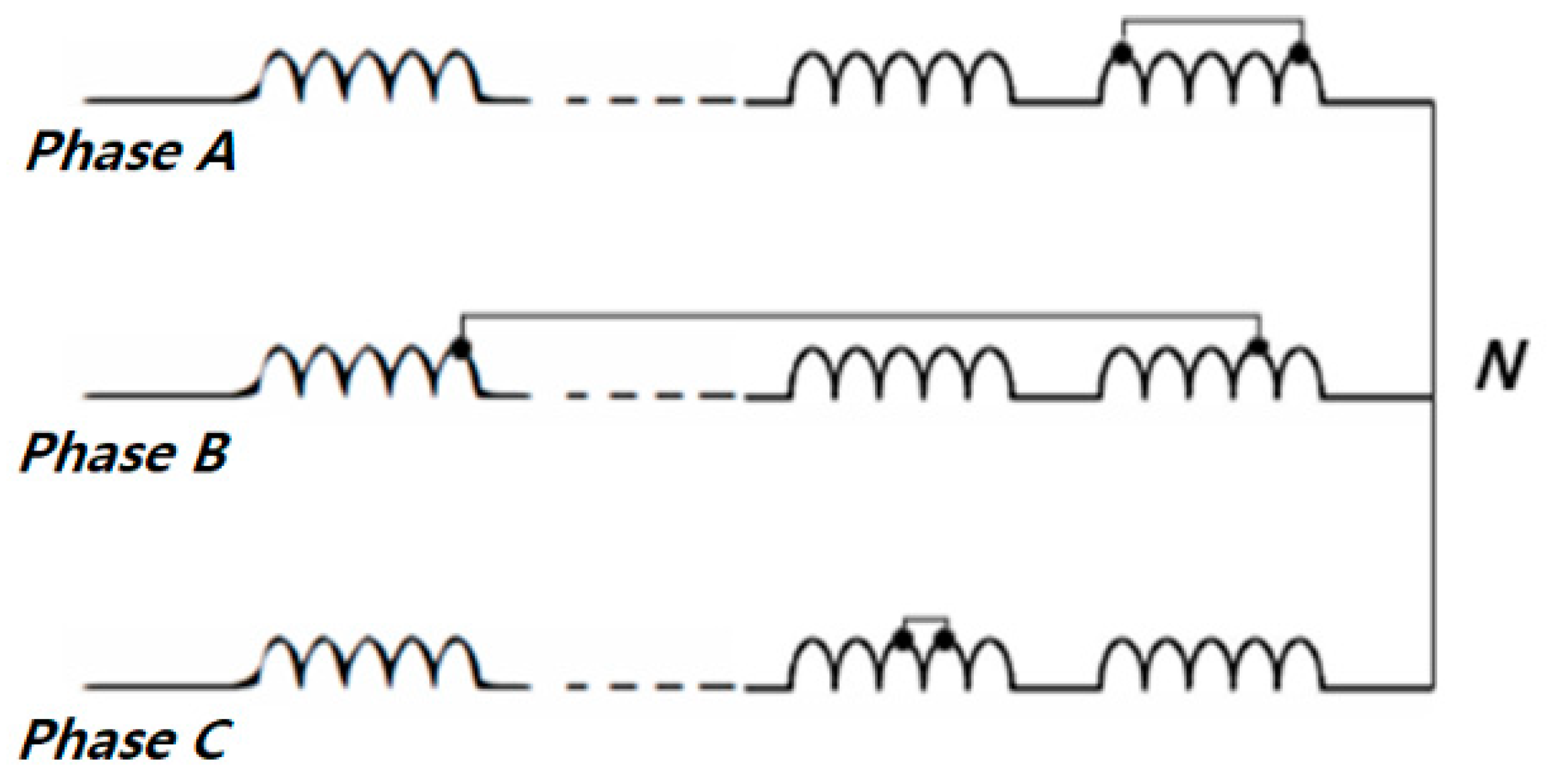



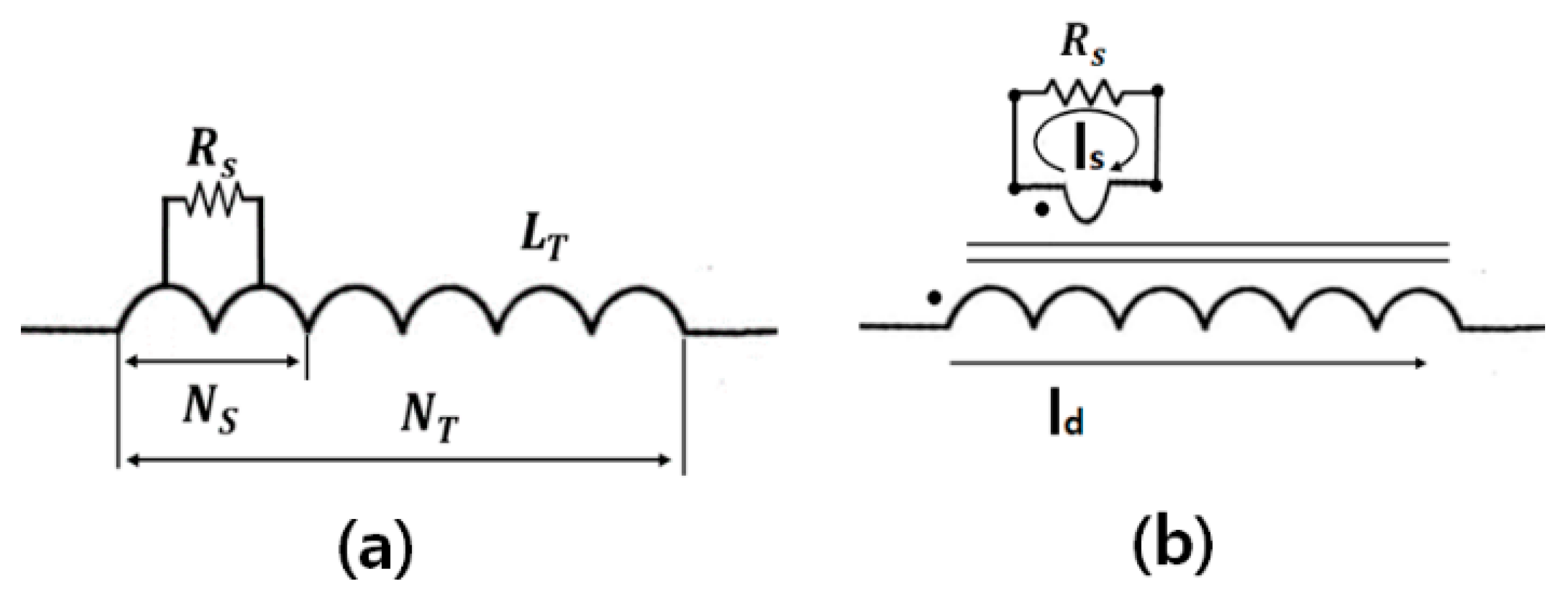

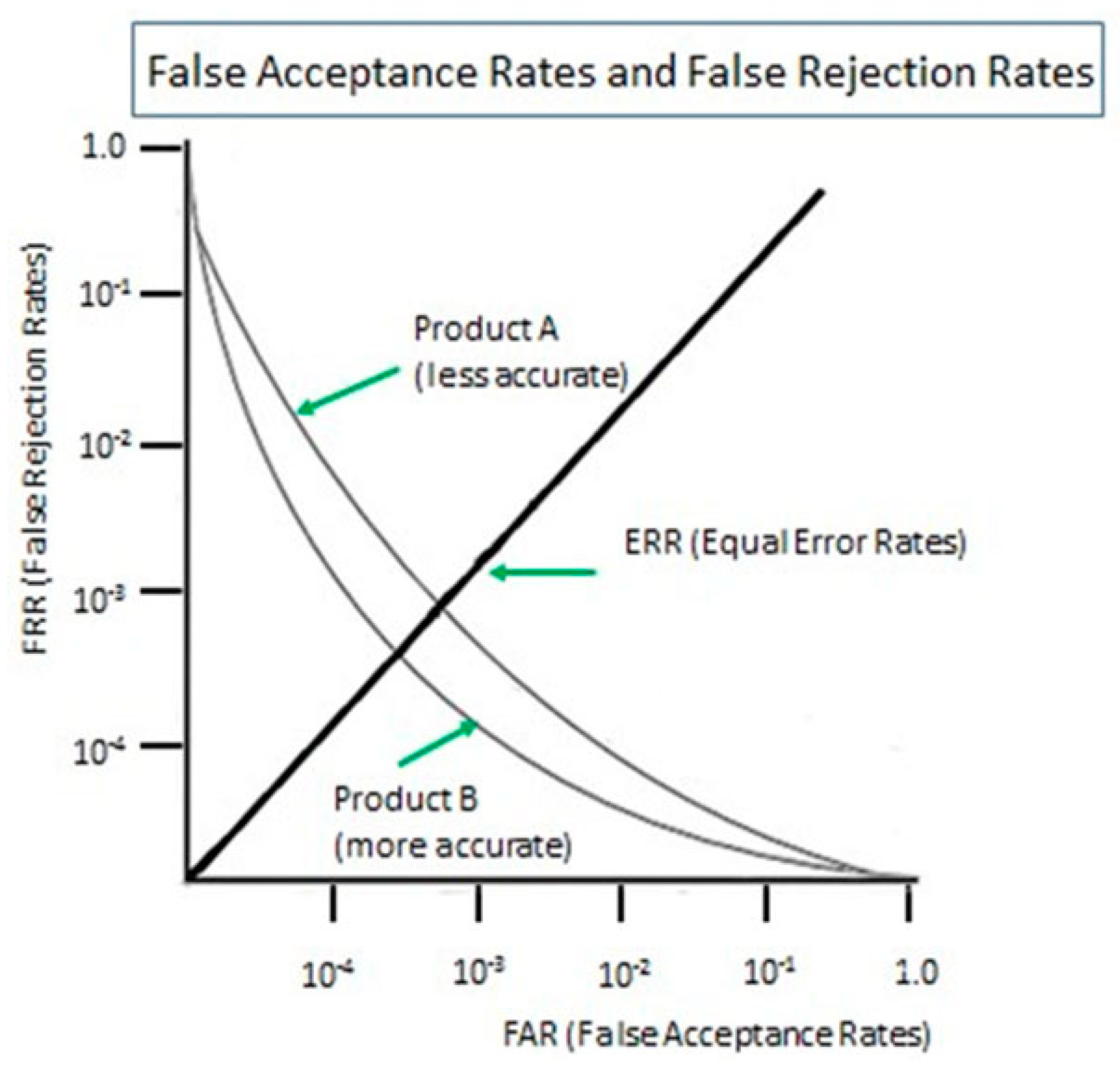


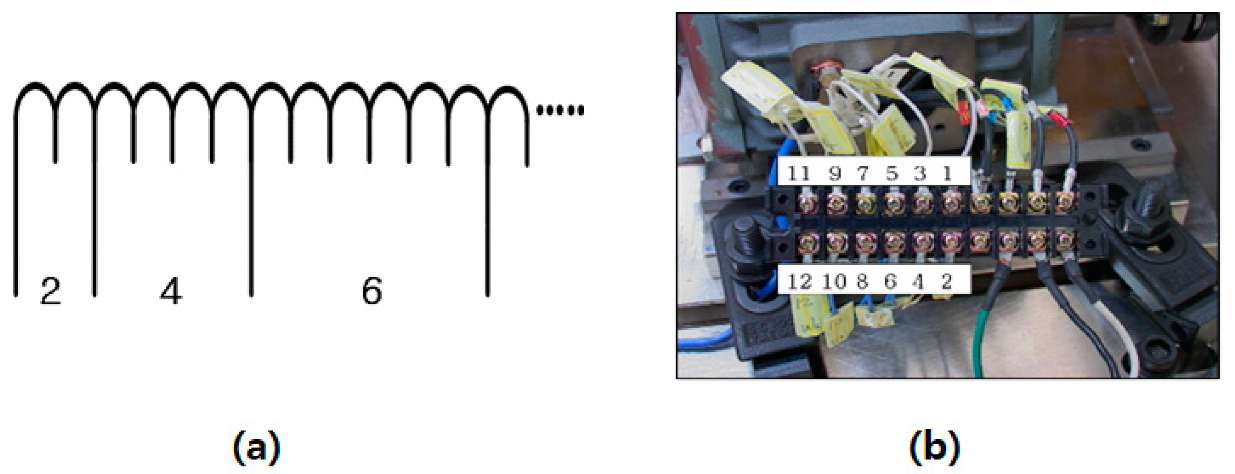
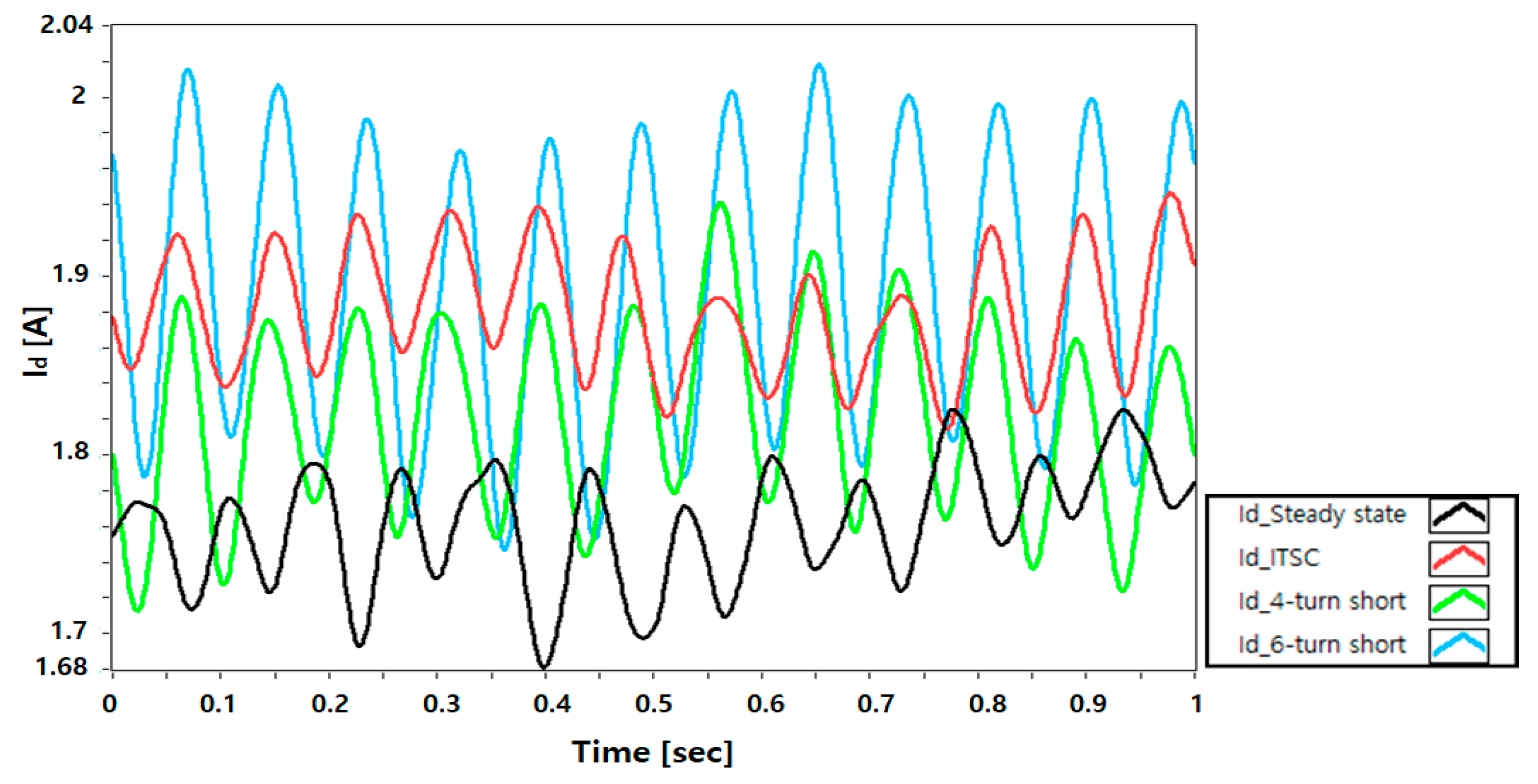
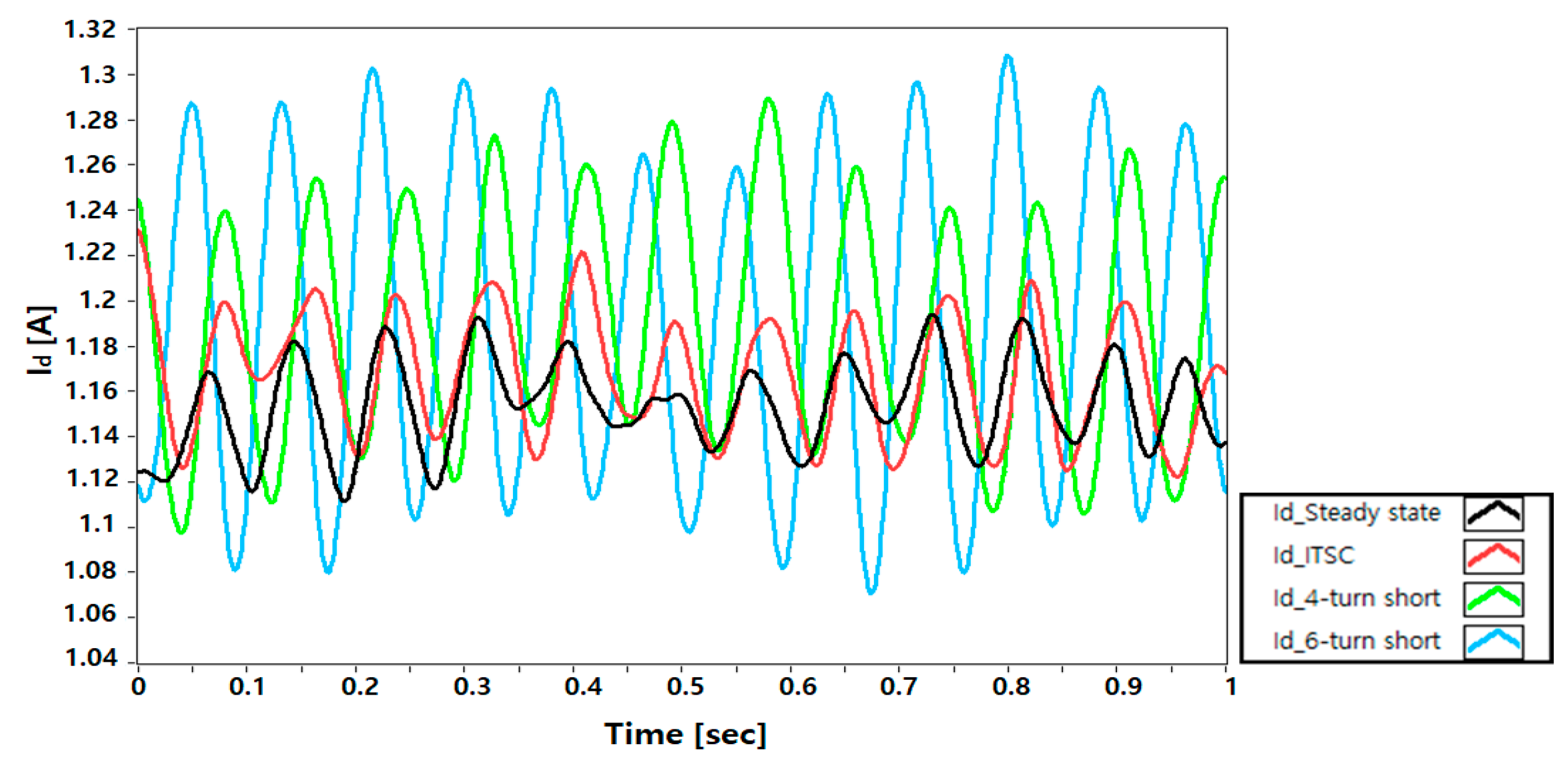
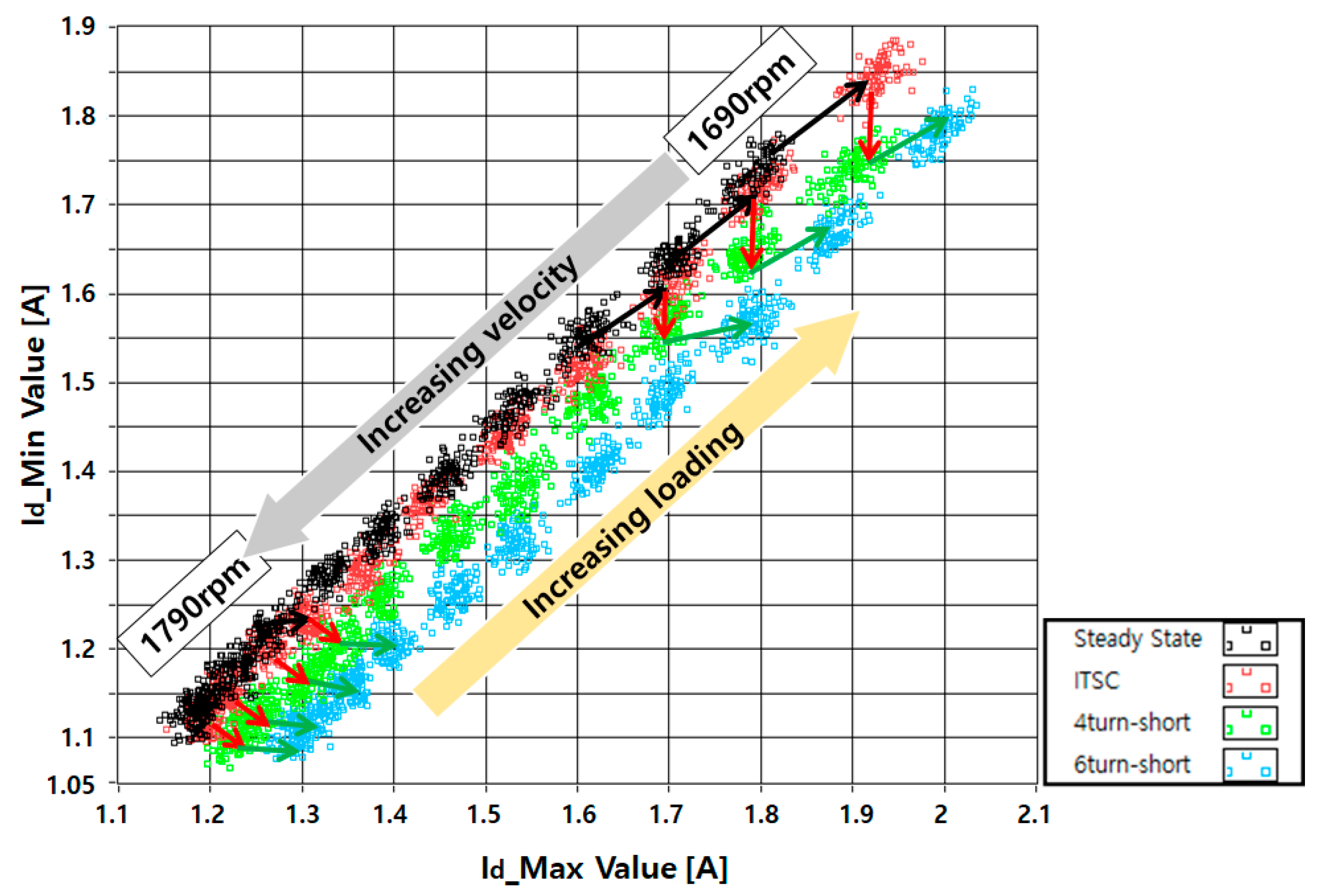

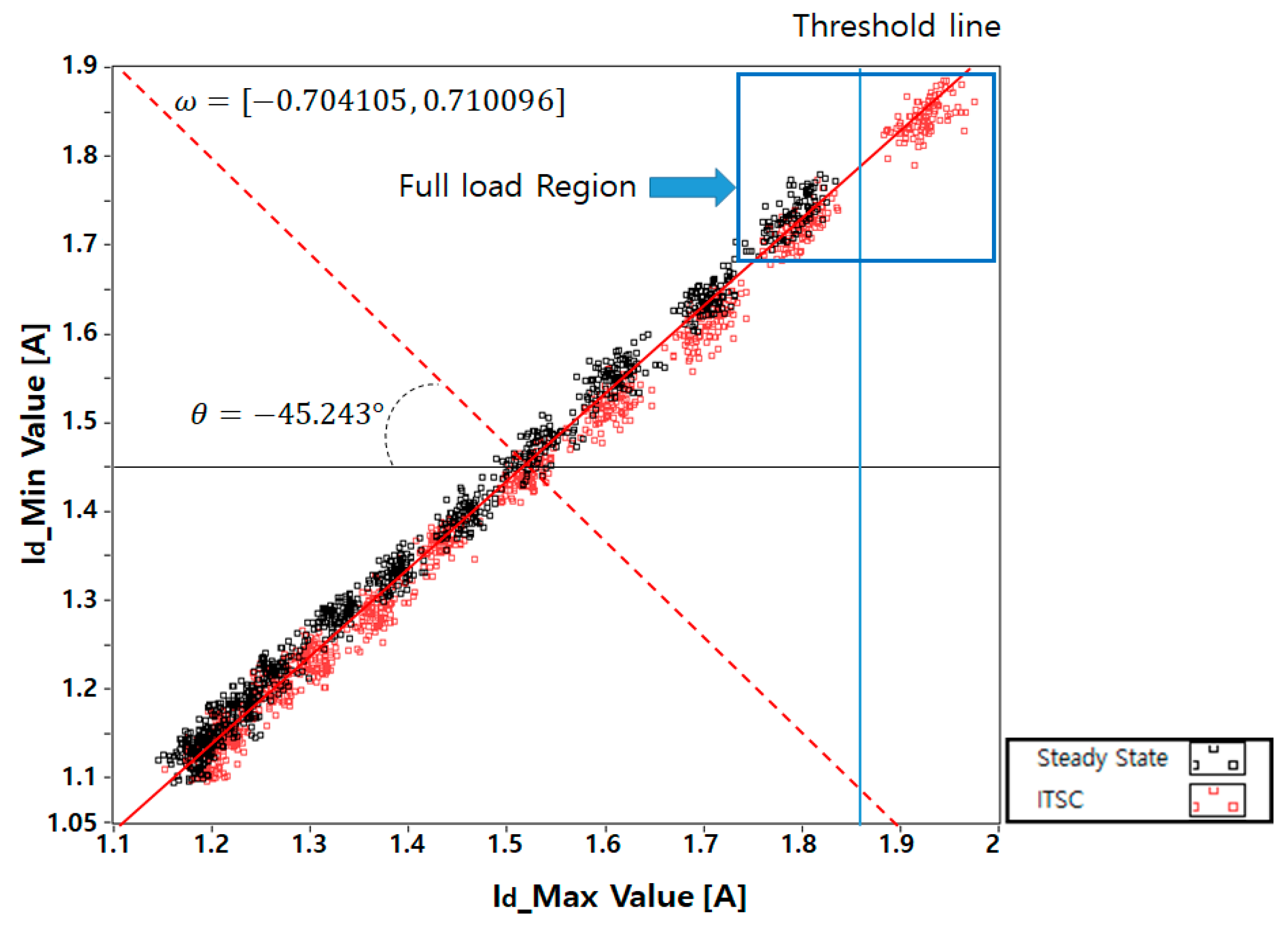
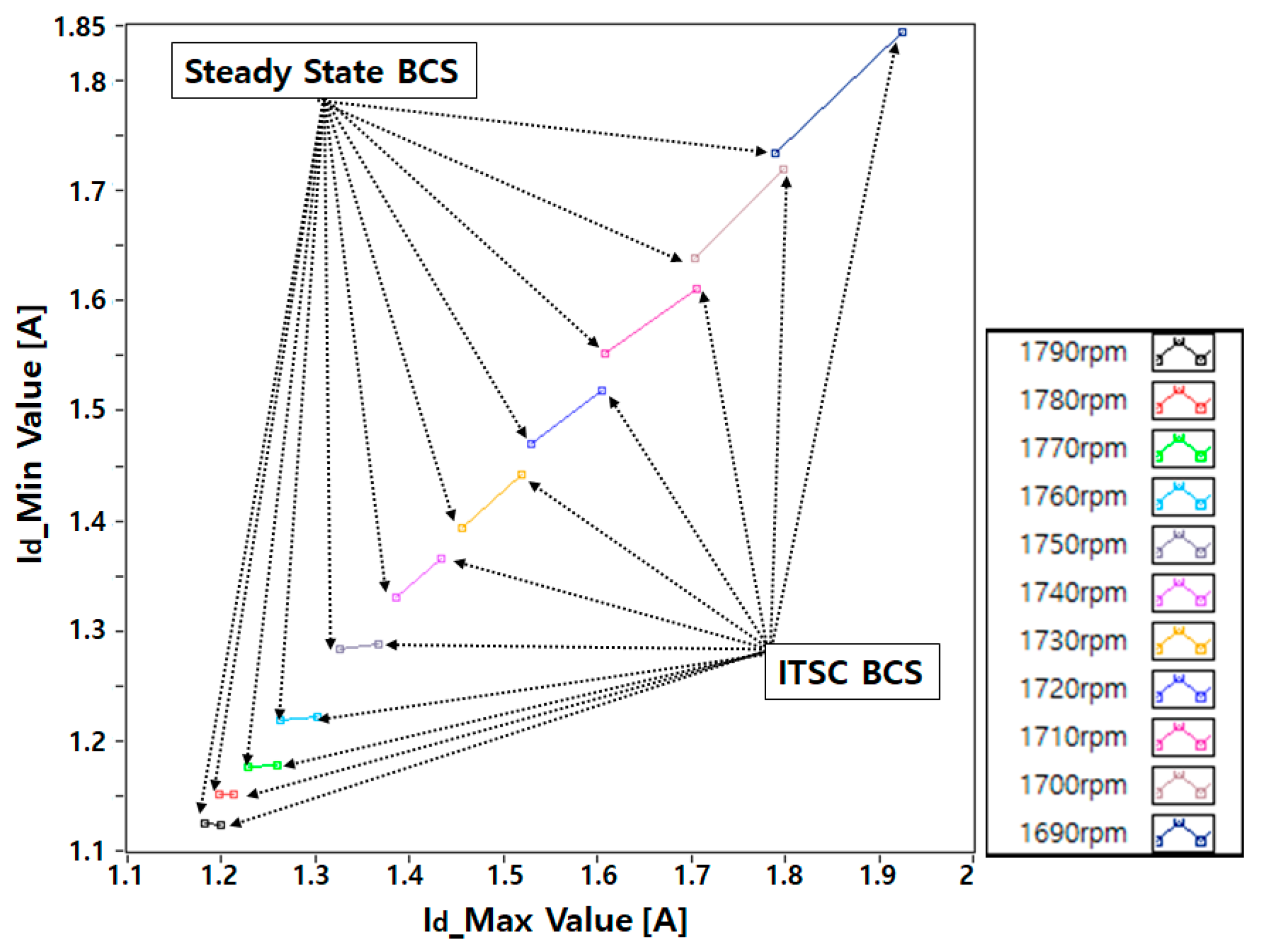
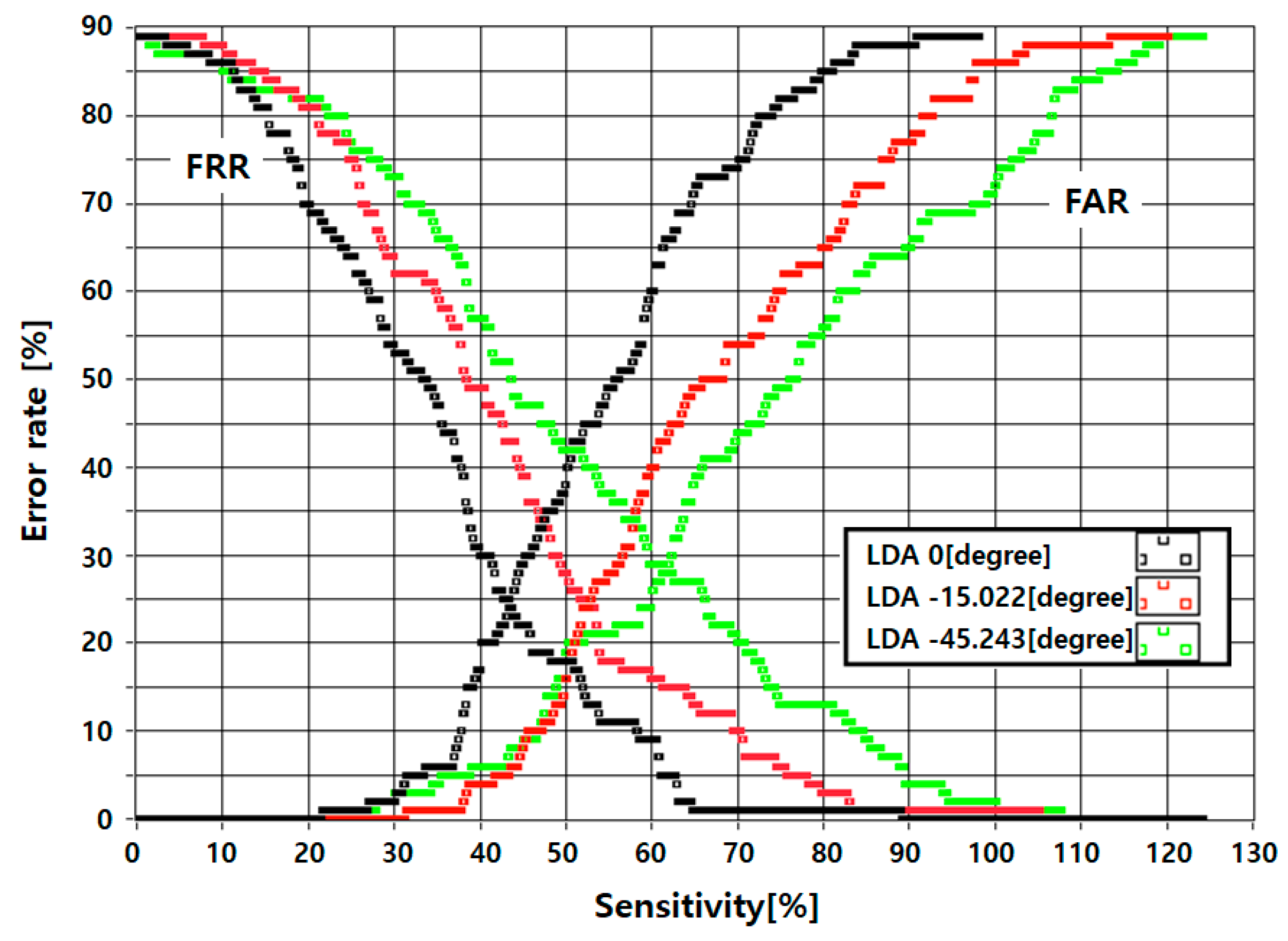
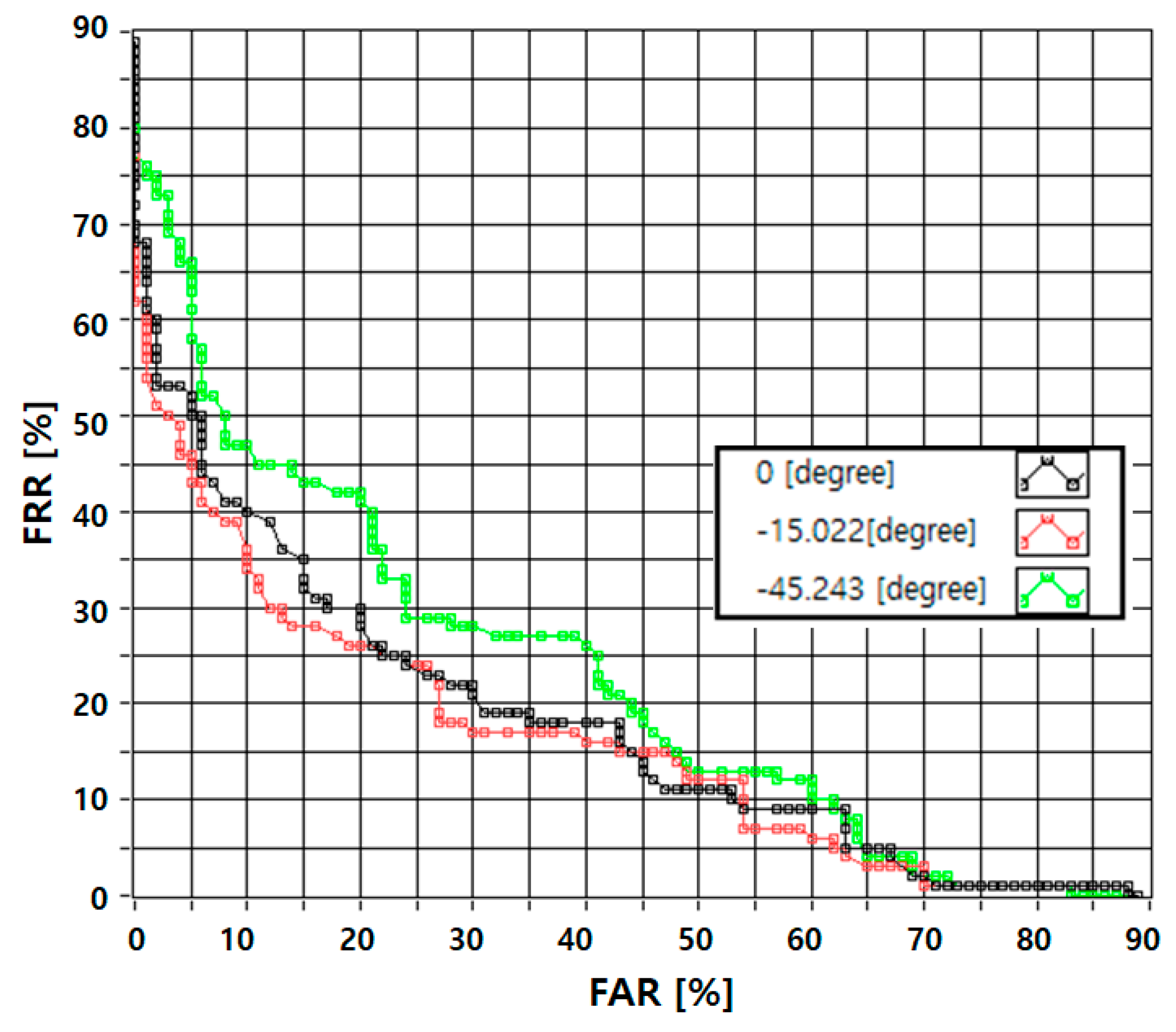
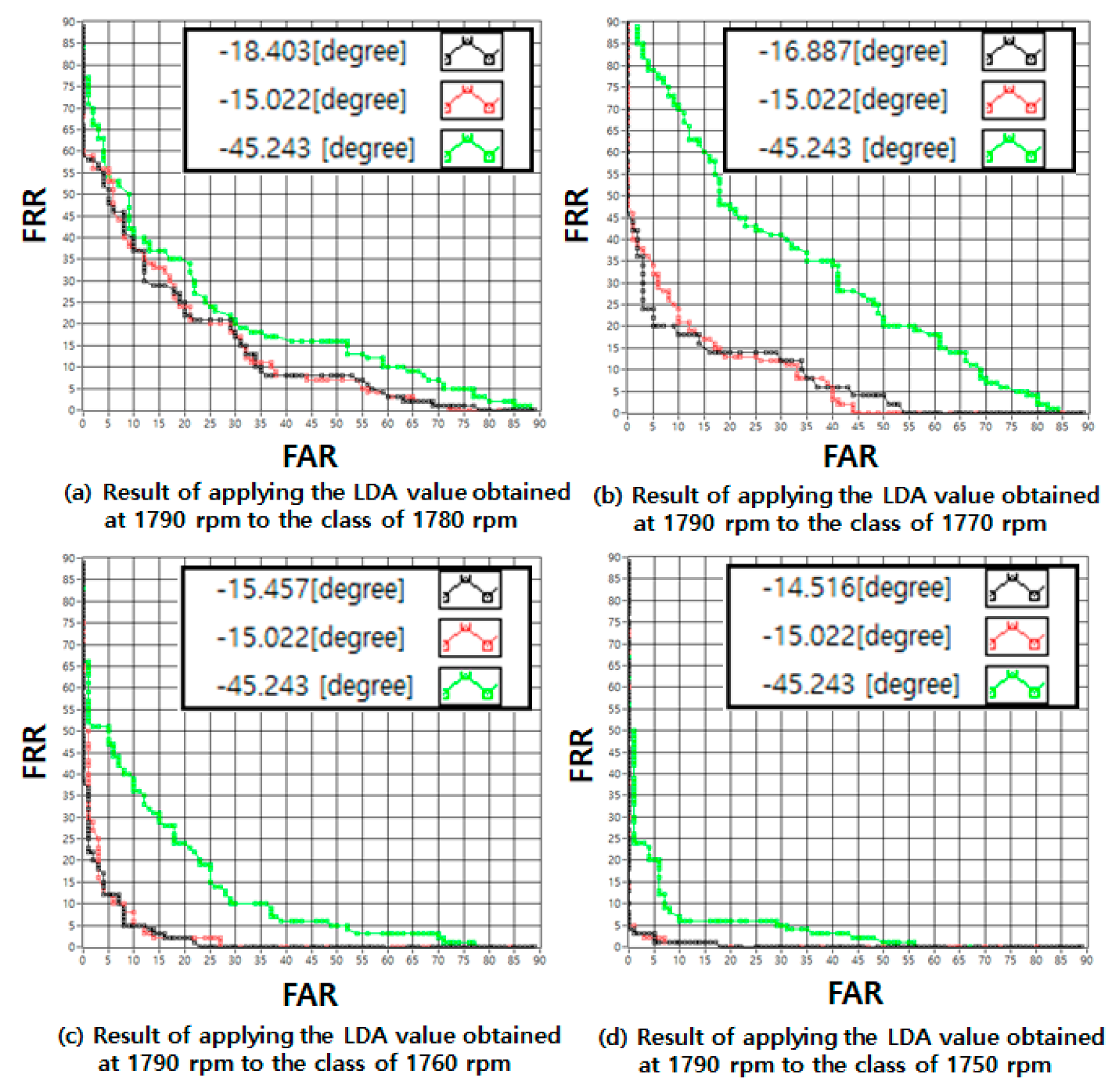
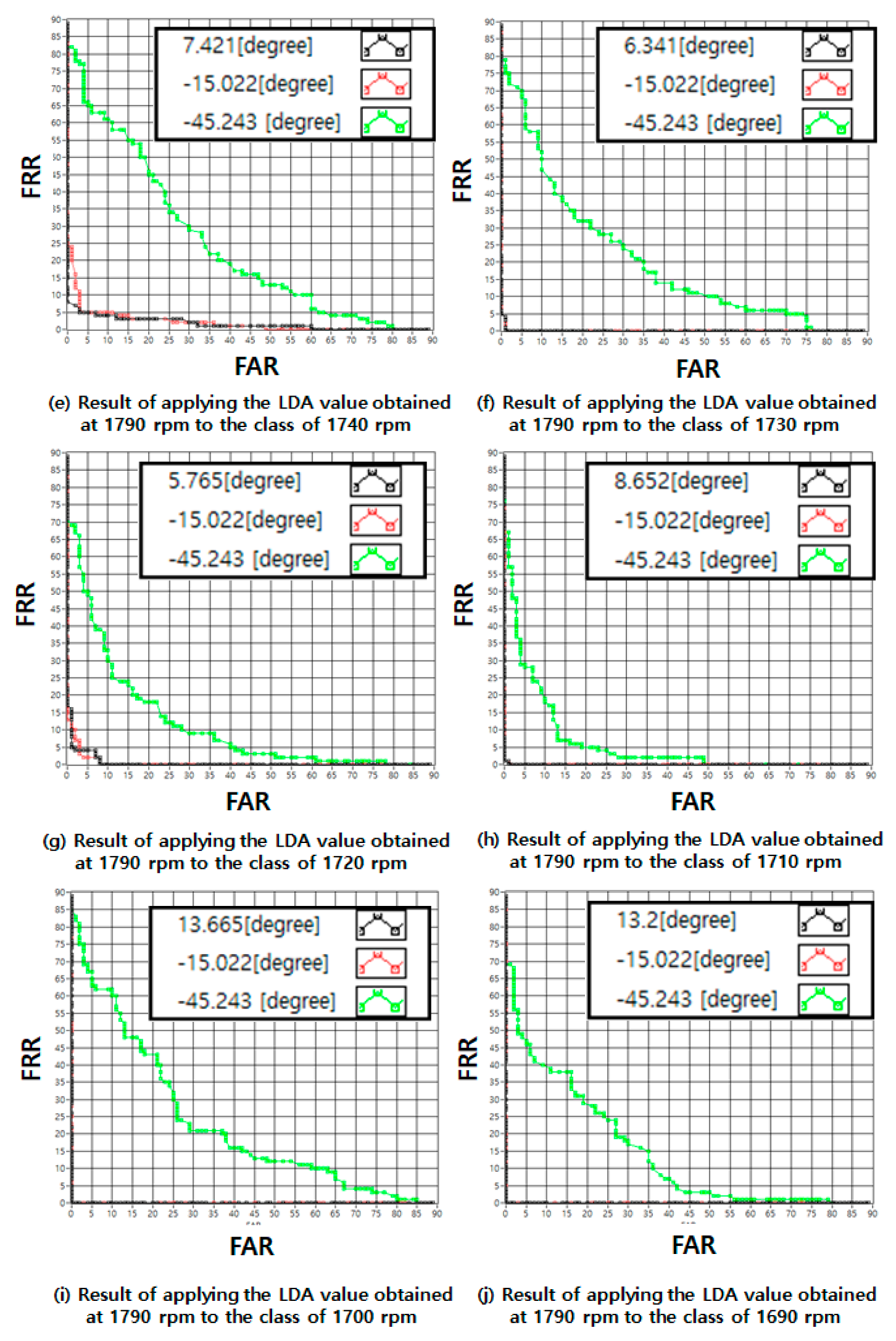
| Description | Value |
|---|---|
| Power (kW) | 0.75 |
| Input Voltage (V) | 220/380 |
| Full Load Current (A) | 3.8/2.2 |
| Supply Frequency (Hz) | 60 |
| Number of Pole | 4 |
| Number of Rotor Slot | 44 |
| Number of Rotor Slot | 36 |
| Full Load Torque (kg·m) | 0.43 |
| Rated Speed (rpm) | 1690 |
| No. | 1–3 | 3–5 | 5–7 | 7–9 | 9–11 |
|---|---|---|---|---|---|
| Turn short | 2(ITSC) | 4 | 6 | 8 | 12 |
| Speed (rpm) | 1790 | 1780 | 1770 | 1760 | 1750 | 1740 | 1730 | 1720 | 1710 | 1700 | 1690 |
|---|---|---|---|---|---|---|---|---|---|---|---|
| Angle (Degree) | −15.02 | −18.40 | −16.88 | −15.45 | −14.51 | 7.421 | 6.341 | 5.765 | 8.652 | 13.66 | 13.2 |
© 2020 by the authors. Licensee MDPI, Basel, Switzerland. This article is an open access article distributed under the terms and conditions of the Creative Commons Attribution (CC BY) license (http://creativecommons.org/licenses/by/4.0/).
Share and Cite
Goh, Y.-J.; Kim, K.-M. Inter-turn Short Circuit Diagnosis Using New D-Q Synchronous Min–Max Coordinate System and Linear Discriminant Analysis. Appl. Sci. 2020, 10, 1996. https://doi.org/10.3390/app10061996
Goh Y-J, Kim K-M. Inter-turn Short Circuit Diagnosis Using New D-Q Synchronous Min–Max Coordinate System and Linear Discriminant Analysis. Applied Sciences. 2020; 10(6):1996. https://doi.org/10.3390/app10061996
Chicago/Turabian StyleGoh, Yeong-Jin, and Kyoung-Min Kim. 2020. "Inter-turn Short Circuit Diagnosis Using New D-Q Synchronous Min–Max Coordinate System and Linear Discriminant Analysis" Applied Sciences 10, no. 6: 1996. https://doi.org/10.3390/app10061996





